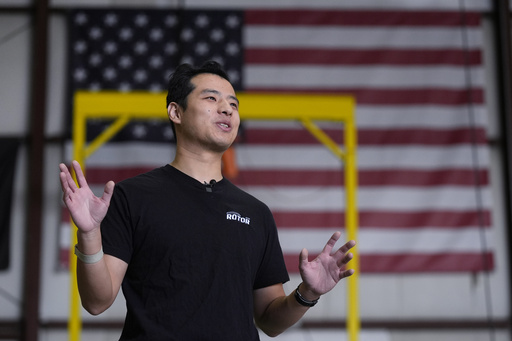
HENNIKER, N.H. — During his college years, Hector Xu faced several challenging experiences while training to operate helicopters at night. These intense encounters sparked his interest in unmanned aircraft systems, which he pursued while completing his PhD in aerospace engineering at the Massachusetts Institute of Technology. In 2021, he established Rotor Technologies with the goal of creating unmanned helicopters.
Currently, Rotor Technologies has developed two autonomous Sprayhawk helicopters, with plans to have around 20 available for commercial release next year. In addition to this, the company is working on helicopters that can transport cargo in disaster-stricken areas and provide support to offshore oil rigs. These innovative helicopters may even play a role in combating wildfires.
At present, Rotor is concentrating its efforts on the agricultural sector, which has already begun utilizing drones for automation. However, the company believes unmanned helicopters can cover larger areas more effectively when it comes to spraying pesticides and fertilizers. On Wednesday, Rotor is scheduled to showcase a public flight test featuring its Sprayhawk at an agriculture aviation trade exhibition in Texas.
“We would receive inquiries from potential clients expressing interest in using our technology for crop dusting,” Xu noted, implying that the significant number of inquiries highlighted a major market opportunity. The Sprayhawk recently demonstrated its capabilities during an initial test flight, where it hovered, moved forward, and sprayed a section of pavement before landing.
Rotor’s Sprayhawk helicopter, valued at nearly $1 million, is based on the Robinson R44 model. In a notable modification, the original four seats have been replaced with sophisticated flight computers and communication systems, allowing for remote operation. The helicopter is outfitted with five cameras and advanced laser sensing technology paired with a radar altimeter, enhancing its terrain awareness. Additionally, it employs GPS and motion sensors for improved navigation.
Located in Nashua, New Hampshire, Xu emphasized that this technology significantly enhances visibility of terrain, particularly in the dark. One of the primary advantages of automating agricultural aviation is improved safety.
Pilots operating crop dusters typically fly at speeds around 150 miles per hour, only about 10 feet above the ground. This risky environment results in numerous accidents each year due to collisions with power lines, cell towers, and other aircraft. Factors such as outdated aircraft and pilot fatigue contribute to these mishaps. A report from the National Transportation Safety Board indicated over 800 agricultural operation accidents happened between 2001 and 2010, including 81 fatalities. Another study from the National Agricultural Aviation Association revealed roughly 640 accidents since 2014, resulting in 109 deaths.
“This profession can be incredibly perilous, resulting in multiple fatalities each year,” remarked Dan Martin, a research engineer at the U.S. Department of Agriculture’s Agriculture Research Service. “Farmers maximize their profits in a brief window each year, which may lead to excessive flying hours, often exceeding 10 to 12 hours each day.”
Furthermore, workers often face health risks from exposure to various chemicals. In recent years, safety concerns paired with cost-effectiveness have increased the popularity of drones among farmers, with projections suggesting approximately 10,000 drones may be sold this year alone.
However, the limited size and battery life of these drones restrict their operational coverage compared to traditional planes and helicopters. This limitation opens the door for companies like Rotor and Pyka, which is also developing larger unmanned aircraft. In August, Pyka announced the successful sale of its first autonomous electric aircraft designed for crop protection to a U.S. client. Their Pelican Spray, a fixed-wing aircraft, gained FAA approval last year for commercial crop protection use and has also been sold for operations in Honduras and Brazil.
Lukas Koch, chief technology officer at Heinen Brothers Agra Services—the buyer of the Pelican Spray—believes that unmanned aircraft represent an impending transformation in the agricultural sector, potentially reducing costs and enhancing safety for farmers. Heinen Brothers operates from airports across states ranging from Texas to Illinois. Koch sees unmanned aircraft as a complement to their existing pilot workforce, particularly in hazardous situations.
“The main benefit is the removal of pilots from aircraft during the most dangerous operations,” Koch explained. “Many fields are constrained by treeline boundaries, tall power lines, and other hazards, making flying quite challenging.”
Nonetheless, Koch expressed that while autonomous aviation could pose new risks to an already busy airspace, such hazards are less impactful in rural regions with ample open land. “The introduction of more unmanned systems could create additional risks for existing pilots, as there’s uncertainty about how these aircraft will respond in various scenarios,” he mentioned. “For instance, if a larger helicopter is operating beyond the pilot’s line of sight, there are numerous questions regarding its potential reactions when encountering manned aircraft.”
To mitigate risks, Rotor has built-in safety measures that activate if something goes wrong. Their Sprayhawk is equipped with multiple communication systems and, for the moment, remains under the control of a remote pilot. If the ground crew loses communication with the helicopter, they have a system in place, referred to by Xu as a “big red button,” that can safely deactivate the engine and execute a controlled landing. “With this safety mechanism, we will eliminate the chances of an aircraft going missing,” he clarified.
These precautionary measures will greatly assist Rotor in securing FAA regulatory approval for commercial flights of its helicopters. Once this approval is obtained, Xu recognizes that the next step will involve scaling operations to satisfy both domestic demand in the U.S. and in markets like Brazil, which presents considerable agricultural opportunities due to its more relaxed regulatory framework.
“I anticipate the year 2025 to be what Elon Musk describes as ‘production hell’,” Xu stated. “We are transitioning from constructing a handful of units to potentially producing tens or hundreds at scale. These aircraft are departing from being custom-built luxury models and are becoming akin to production vehicles in the automotive industry.”
